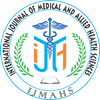Prevalence of Multidrug Resistant Pseudomonas aeruginosa Post-Operative Surgical Site Infections in Exploratory Laparotomy
Pages : 64-69Download PDF
Abstract
Objective: This study examines the antibiotic sensitivity of Pseudomonas aeruginosa strains that are resistant to several drugs and collected from surgical site infections in patients having exploratory laparotomies.
Methodology: This study determines the prevalence of multidrug resistant patterns in P. aeruginosa isolated from clinical wound swabs. The research was conducted at IIMT University Department of Microbiology in Meerut, Uttar Pradesh, India. A total of 82 pus specimens were incubated on Cetrimide and MacConkey agar for 24 hours at 37℃. Colony morphology, microscopy, and biochemical assays were employed to identify P. aeruginosa. The Kirby-Bauer disc diffusion method were used to perform the antibiotic susceptibility test, and the data analysis were done in compliance with the Clinical and Laboratory Standard Institute (CLSI) guidelines.
Result: In total, 82 post-surgical site clinical samples were collected from wound swabs. In 24 cases, P. aeruginosa were detected (29.27%). Overall, 10 isolates (41.67%) showed multidrug resistance, meaning they could withstand three or more classes of antibiotics. High sensitivity was demonstrated by piperacillin (70.83%) and ofloxacin (70.83%). The resistance to ciprofloxacin was 87.50%. The first antibiotic that P. aeruginosa isolates demonstrated resistance to ciprofloxacin, which were followed by ampicillin/sulbactam, gentamicin, amikacin, piperacillin, and ofloxacin.
Conclusion: In addition to harming patients, postoperative wound infections significantly impair healthcare systems in terms of financial costs, morbidity, and mortality.
Keywords: Exploratory Laparotomy, Multidrug resistant, P. aeruginosa, Surgical Site Infections, Wound swab, Disc-diffusion.





